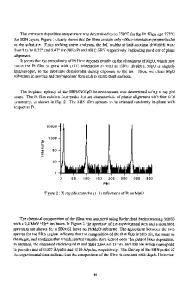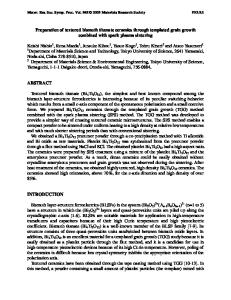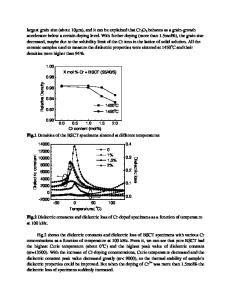Dielectric and piezoelectric properties of textured Sr 0.53 Ba 0.47 Nb 2 O 6 ceramics prepared by templated grain growth
- PDF / 445,748 Bytes
- 11 Pages / 612 x 792 pts (letter) Page_size
- 58 Downloads / 327 Views
Fiber textured Sr0.53Ba0.47Nb2O6 ceramics were reactively sintered to 艌95% of the theoretical density from a mixture of SrNb2O6 and BaNb2O6 powders. Texture in 〈001〉 was obtained by templated grain growth on 〈001〉-oriented acicular KSr2Nb5O15 template particles. The most highly textured ceramics had a peak dielectric constant of 23,600 (at Tc ⳱ 128 °C), a remanent polarization (Pr) of 20.3 C/cm2, a saturation polarization (Psat) of 24 C/cm2 (69–96% of single crystal), and a piezoelectric charge coefficient (d33) of 84 pC/N (76–93% of single crystal). A model, correlating polarization with grain orientation, predicts that Pr increases sharply when a percolating grain network forms to transfer charge between elongated grains.
I. INTRODUCTION
Electroceramics are used in a variety of applications such as sensors, actuators, capacitors, and varistors. In these applications, the ceramic microstructure often consists of equiaxed, randomly oriented grains. Ferroelectric transducers require poling to obtain useful piezoelectric properties. Poling is difficult for some ferroelectric ceramics because the symmetry-related orientations available for the spontaneous polarization are limited.1 Nagata et al.2 achieved anisotropic properties by hot pressing SBN ceramics (x ⳱ 0.30–0.65), but their polarization values were well below the single-crystal values. In an earlier paper, we reported enhanced electrical properties in highly textured Sr0.53Ba0.47Nb2O6 (SBN53) ceramics fabricated by templated grain growth (TGG).3 Acicular KSr2Nb5O15 (KSN) particles (5 to 15.4 wt%) and V2O5 (0.8 mol%) were used as template and liquid former, respectively. It was found that texture development started at T < 1000 °C due to melting of V2O5 at 690 °C. Highly grain-oriented ceramics (texture fraction, f, approximately 0.93) had 60–84% of single-crystal saturation polarization and 80–98% of single-crystal strain coefficient (d33) in the polar (c) direction. However, the peak dielectric properties were found to be much lower than the single-crystal values due to the presence of V 2 O 5 -based nonferroelectric phase(s) on the grain boundaries. In addition, small template particles (especially
Data Loading...











